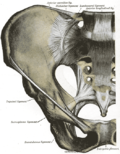| Ischial spine | |
|---|---|
 Capsule of hip-joint (distended). Posterior aspect. (Spine of ischium labeled at upper left.) | |
 Left hip-joint, opened by removing the floor of the acetabulum from within the pelvis. (Spine of ischium labeled at center left.) | |
| Details | |
| Identifiers | |
| Latin | spina ischiadica spina ischiaca spina ischialis |
| TA98 | A02.5.01.205 |
| TA2 | 1343 |
| FMA | 17028 |
| Anatomical terms of bone | |
The ischial spine is part of the posterior border of the body of the ischium bone of the pelvis. It is a thin and pointed triangular eminence, more or less elongated in different subjects.



